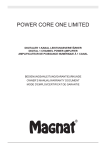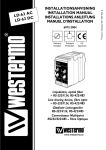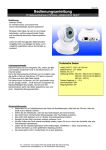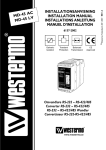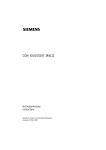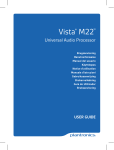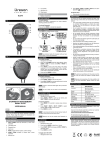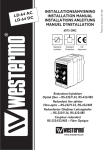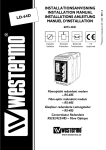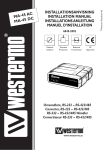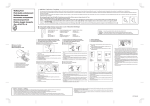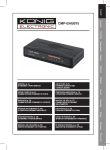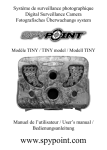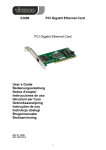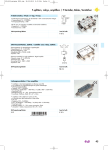Download INSTALLATIONSANVISNING INSTALLATION MANUAL
Transcript
INSTALLATIONSANVISNING INSTALLATION MANUAL INSTALLATIONS ANLEITUNG MANUEL D’INSTALLATION 6611-2001 Galvanic Isolation Transient Protection Balanced Transmission Multidropp 2-tråd Multidrop 2-wire Multidrop 2-Draht Multipoints 2-fils www.westermo.com CE Approved © Westermo Teleindustri AB • 2002 • REV. C DC / C A 9 TD-2 em d o m FSK Innehållsförteckning 1. Säkerhet .......................................................................................................................................................................... 2. Godkännanden ....................................................................................................................................................... 2.1 Tillverkningsdeklaration (Declaration of conformity) ............................................................. 3. Introduktion .............................................................................................................................................................. 3 4 5 6–7 Anslutningar ............................................................................................................................................................. 6 Isolation mellan gränssnitten ...................................................................................................................... 6 Temperaturområde ............................................................................................................................................ 6 Mekanik ........................................................................................................................................................................ 7 Räckvidd och signaldämpning ..................................................................................................................... 7 Vändtider .................................................................................................................................................................... 7 4. Specifikationer 4.1 4.2 4.3 4.4 4.5 4.6 3 5. Underhåll ................................................................................................................................................ ....................................................................................................................................................................... 8 8–12 6.1 Montering/Demontering ................................................................................................................................. 8 6.2 Anslutningar ............................................................................................................................................................. 9 6.3 Lysdiodsindikeringar ........................................................................................................................................... 9 6.4 Gränssnitt 1 (RS-232) .................................................................................................................................... 10 6.5 Gränssnitt 2 (RS-422/485) .......................................................................................................................... 10 6.6 Gränssnitt 3 ........................................................................................................................................................... 10 6.7 Matning DC anslutning ................................................................................................................................. 10 6.8 Matning AC anslutning .................................................................................................................................. 10 6.9 Inställning ...................................................................................................................................................... 11–12 6.9.1 Switchinställningar ...................................................................................................................... 11–12 6. Installation ........................................................................................................................................................ 13–14 Blockdiagram ....................................................................................................................................................... 13 RS-422/485 anslutning ................................................................................................................................... 13 Linjeanslutning .................................................................................................................................................... 14 7. Funktionell beskrivning 7.1 7.2 7.3 SE.2 ................................................................................................................ 6611-2001 1. Säkerhet ! ! ! Allmänt: Innan enheten används, läs denna manual fullständigt och jämför med uppgifter på enheten, samt säkerställ att du har förstått all information. Kontrollera att användandet av enheten i din installation inte kommer att överskrida specificerade säkerhetsprestanda för enheten. Före installations-, underhålls- eller modifieringsarbete: Potentialutjämna dig till en jordnings punkt (tex. genom att använda handledsband), så att skada av intern elektronik på grund av elektrostatiska urladdningar (ESD) förhindras. Koppla ifrån enheten från AC/DC matningsnät samt alla andra elektriska anslutningar, så att åtkomst till farliga spänningar förhindras. Installation: Enheten är konstruerad för användning i professionella system. Enheten skall installeras i utrymmen med begränsad åtkomst, t ex låsbart skåp med tillträde endast för service personal. Enheten är konstruerad för fast anslutning till AC/DC matningsnät och skall installeras av behörig personal. Enhetens anslutning till matningsnätet skall vara tillräckligt avsäkrat, och om så krävs skall det vara möjligt att manuellt koppla från enheten från matningsnätet. Observera att nationella installations regler skall följas. Enhet med märkspänning överskridande 42,4 V topp eller 60 V DC, är en klass I utrustning som skall skyddsjordas. Enhet med märkspänning upp till 42,4 V topp eller 60 V DC, är en klass III utrustning som skall vara separerad från farliga spänningar med dubbel eller förstärkt isolation. Enheten kyls genom konvektion. Följ föreskrivna monterings rekommendationer för att förhindra störningar i kylande luftström kring enheten (se Installation). TD-29 är avsedd att användas på dedikerade linjer och får ej kopplas in på allmänna eller hyrda telelinjer. Ej kodkänd enligt Europeisk standard CTR-15. 2. Godkännanden Uppfyllande av direktiv 73/23/EEC (lågspännings direktivet) har säkerställt genom tillämpning av standard EN60950. Uppfyllande av direktiv 89/339/EEC (elektromagnetisk kompabilitet) har säkerställts genom tillämpning av standard EN61000-6-2 (immunitet i industrimiljö) och standard EN61000-6-3 (emission från utrustning i bostäder, kontor och liknande miljö). 6611-2001 SE.3 2.1 Tillverkningsdeklaration (Declaration of conformity) SE.4 6611-2001 3. Introduktion TD-29 är konstruerad för kommunikation på 2-tråds partvinnad kopparkabel. Multidropp och punkt till punkt förbindelser med halvduplex är möjliga.TD-29 klarar halv duplex med 19.2 kbit/s som maximal överföringshastighet. TD-29 kan ställas in för att passa olika driftsförhållanden med hjälp av omkopplare. Såväl antal databitar som sändar- och mottagarnivåer samt olika kommunikationsgränssitt kan väljas. Utrustningar kan anslutas via 9-polig D-sub alternativt skruvplint (RS-232) eller skruvplint (RS-422/485). Fyra alternativa överföringshastigheter finns. När modemet är anslutet via RS-232 gränssnittet kan kommunikationsriktningen kontrolleras med eller utan hårdvaruhandskakning (RTS). Vid multidroppförbindelser är räckvidden beroende av hur många enheter som är anslutna till bussen. (Se kapitel 4.5) 1 2 R+ R- RS-232 3 4 5 T+ T- 6 7 T+ T- CHANNEL 3 8 1 R+ R- CHANNEL 4 PWR RD 2 R+ R- Dedikerad linje 3 4 5 T+ T- 8 R+ R- RD TD TD DCD2 DCD3 DCD3 DCD4 DCD4 CHANNEL 2 R+ R- T+ T1 2 3 4 5 POWER 12-36V DC - RS-422/485 POWER 12-36V DC - 7 CHANNEL 4 PWR DCD2 CHANNEL 2 R+ R- T+ T1 2 3 4 6 T+ T- CHANNEL 3 6611-2001 SE.5 4. Specifikationer 4.1 Anslutningar Matning TD-29 AC Märkspänning Arbetsspänning Märkström Märkfrekvens Anslutning Anslutningsbar area TD-29 DC 115 V/230 VAC 24 VDC 104–132/207–264 VAC 12–36 VDC 24 mA/12mA 200 mA 48–62 Hz – 3-polig skruvplint 2-polig skruvplint 0,2–2,5 mm2 (AWG 24-12) TD-29 36–55 VDC 48 VDC 36–55 VDC 50 mA – 2-polig skruvplint RS-422/485 Elektrisk specifikation Datahastighet Anslutning Anslutningsarea Kretstyp RS-422/485 2 400–19.2 kbit/s 5-polig skruvplint 0,2–2,5 mm2 (AWG 24-12) TNV-1, partvinnade ledare, ej krav på skärm RS-232 Elektrisk specifikation Datahastighet Anslutning Kretstyp RS-232 2 400 bit/s–19.2 kbit/s 9 polig D-sub, DCE SELV, max 15 m längd, ej krav på skärm FSK-linje Elektrisk specifikation Datahastighet Anslutning Anslutningsarea Kretstyp – 2 400 bit/s–19.2 kbit/s 2 polig skruvplint 0,2–2,5 mm2 (AWG 24-12) TNV-3 4.2 Isolation mellan gränssnitten Matning till övriga FSK-linje till övriga SE.6 AC: 3 kV RMS @ 50 Hz och 60s varaktighet DC: 1 kV RMS @ 50 Hz och 60s varaktighet 1,5 kV RMS @ 50 Hz och 60s varaktighet 6611-2001 4.3 Temperaturområde Temperatur, drift Temperatur, lagring och transport Relativ fuktighet, drift Relativ fuktighet, lagring och transport 5–50°C –40 till +85°C 0 till 95% (icke kondenserande) 0 till 95% (kondensation utanför förpackning tillåten) 4.4 Mekanik Dimension (B x H x D) Vikt Montering Skyddsklass, mot åtkomst 55 x 100 x 128 mm 0,5 kg 35 mm DIN skena IP 20 (IEC 529) 4.5 Räckvidd och signaldämpning Överföringshastighet (bit/s) Räckviddpunkt till punkt (km) Dämpning (dB/km) Dämpning hastighet per ansluten enhet (multidropp) (dB) 2 400 16 1,5 0,2 4 800 14 1,7 0,2 9 600 11 2,1 0,3 19 200 9 2,5 0,4 Uppmätt på Cat. 5 kabel UTP 4x2x24AWG. Signalnivå > –24 dBm. Räckvidden är beroende av linjens kvalitet. 4.6 Vändtider RS-485 Hastighet bit/s Vändtid µs 2 400 800 4 800 400 9 600 320 19 200 300 6611-2001 SE.7 5. Underhåll Inget krav på underhåll, så länge enheten används på avsett sätt inom specificerade förutsättningar. 6. Installation 6.1 Montering/Demontering Före montering eller demontering av enheten: Potentialutjämna dig till en jordnings punkt (tex. genom att använda handledsband), så att skada av intern elektronik på grund av elektrostatiska urladdningar (ESD) förhindras. Koppla ifrån enheten från AC/DC matningsnät samt alla andra elektriska anslutningar, så att åtkomst till farliga spänningar förhindras. CLICK! Montering Enheten är avsedd att monteras på en 35 mm DIN skena vilken skall vara horisontellt fastsatt, tex. på en vägg eller montageplåt i skåp. Enheten kyls genom konvektion. För att förhindra störningar i kylande luftström kring enheten krävs ett fritt utrymme på 25 mm ovan/nedan och 10 mm till vänster/höger om enheten. Snäppfastsättning utan verktyg, se figur. Min 10 mm (0.4 inches) Demontering Pressa ner den svarta hållaren på enhetens nedre del med hjälp av en skruvmejsel, se figur. SE.8 6611-2001 6.2 Anslutningar RS-232 5-polig skruvplint RS-422/RS-485 4-polig skruvplint 9-polig D-sub RS-232 Lysdioder Linjeanslutning Matningsanslutning 6.3 Lysdiodsindikeringar PWR RD TD RTS DCD CTS 6611-2001 LED LED LED LED LED LED LED LED LED LED LED LED till från till från till från till från till från till från Matningsspänning korrekt Ingen matningsspänning Mottagen linjedata Ingen mottagen data Sänd linjedata Ingen sänddata RTS från inkopplad utrustning Ingen RTS från inkopplad utrustning DCD aktiv DCD inaktiv CTS signal aktiv CTS signal inaktiv SE.9 1 2 3 4 5 6 7 8 9 9 6.4 Gränssnitt 1 (RS-232) 9-polig D-sub Ansl. nr. 9-polig Skruvplint Riktning 1 2 3 4 5 6 7 8 9 – 4 3 – 5 – 2 1 – – ut in – – ut in ut – 8 7 6 5 4 3 2 1 6 5 4 3 Beskrivning – RD/Received Data TD/Transmitted Data – SG/Signal Ground DSR/Data Set Ready RTS/Request to Send CTS/Clear to Send – 6.5 Gränssnitt RS-422/485 9-polig Skruvplint Riktning ITU-T V.11 Benämning 9 8 7 6 in ut in/ut in/ut A’ (R+) B’ (R–) A (T+) B (T–) 9 Beskrivning RS-422 Mottagare RS-422 Mottagare RS-422/485 Sändare/mottagare RS-422/485 Sändare/mottagare 8 7 2 1 Definitionen R+/R–,T+T– kan variera mellan olika tillverkare. 6.6 Linjegränssnitt 2-polig skruvplint Riktning 1 2 in/ut in/ut Beskrivning 1 2 1 2 Sändare/mottagare (2-tråd) 6.7 Matning DC anslutning Anslutning Benämning Beskrivning 1 2 – + 0 V DC 12–55 VDC 6.8 Matning AC anslutning Benämning Beskrivning N L N SE.10 115*/230 VAC 115*/230 VAC PE/skyddsjord L * Specialversion 115 VAC 6611-2001 6.9 Inställning S2:1–4 1 2 3 4 5 6 7 8 9 S1:1–8 6.9.1 Switchinställningar DIP-switchar är tillgängliga under locket på toppen av modemet. DIP-switcharna används för att konfigurera enheten. ! Varning! Potentialutjämna dig till en jordnings punkt (tex. genom att använda handledsband), så att skada av intern elektronik på grund av elektrostatiska urladdningar (ESD) förhindras, innan locket på modemets topp tas av. ! Varning! Öppna ej ansluten enhet. Koppla ifrån enheten från AC/DC matningsnät samt alla andra elektriska anslutningar, så att åtkomst till farliga spänningar förhindras. OBS Vid inställning med hjälp av DIP-switchar kommer utförd inställning att gälla efter tillslag av AC/DC matning. Om det under drift sker inställning med någon annan metod, åsidosätts DIP-switch inställningen. Efter förnyat tillslag av AC/DC matning så har dock DIPswitch inställningen företräde framför utförd inställning med någon annan metod. 6611-2001 SE.11 Switchblock 1 – S1 Val av antal databitar Val av Bärvågsaktivering ON S1 10 bitar ON 1 2 3 4 5 6 7 8 Data S1 1 2 3 4 5 6 7 8 ON S1 11 bitar ON 1 2 3 4 5 6 7 8 S1 RTS 1 2 3 4 5 6 7 8 Val av överföringshastighet ON S1 Val av uteffekt* 2 400 bit/s 1 2 3 4 5 6 7 8 ON S1 –9 dBm S1 ON 4 800 bit/s 1 2 3 4 5 6 7 8 1 2 3 4 5 6 7 8 ON ON S1 S1 9 600 bit/s 5 dBm 1 2 3 4 5 6 7 8 1 2 3 4 5 6 7 8 * Belastning 600 Ω ON S1 19 200 bit/s 1 2 3 4 5 6 7 8 Val av nivå för DCD avkänning Linjeterminering* ON ON S1 1 2 3 4 5 6 7 8 Ingen terminering S1 Terminering S1 –30 dBm 1 2 3 4 5 6 7 8 ON ON S1 –20 dBm 1 2 3 4 5 6 7 8 1 2 3 4 5 6 7 8 S1: 8 används ej * Terminering av enheten i linjens ändar Switchblock 2 – S2 Terminering av RS-485* Terminering av RS-422* ON ON 1 2 3 4 1 2 3 4 ON ON Terminering S2 Terminering S2 Ingen terminering S2 Ingen terminering S2 1 2 3 4 1 2 3 4 * Terminering av enheten i linjens ändar * Terminering av enheten i linjens ändar Fabriksinställning ON S1 1 2 3 4 5 6 7 8 SE.12 ON S2 1 2 3 4 6611-2001 7. Funktionell beskrivning 7.1 Blockdiagram D-Sub Screw terminal RD TD SG DSR RTS CTS 2 3 6 5 7 CTS RTS TD RD SG B 8 1 2 PWR LED 5V 0V RTS LED Amplifier S1:6 5V 0V Line S1:4 Line switch RD LED 0V S1:7 CTS LED TD LED 0V 5V 0V 3 4 5 A 6 7 B' A' 9 8 0V S2:4 S2:3 S2:2 S2:1 DCD LED MCU FSK Demodulator 0V Power Supply F1 +5V 0V –5V Isolated Power Supply 7.2 RS-422/485 anslutning 4-tråd RS-422 utrustning Tvinnade trådpar TD-29 9 A Sändare Mottagare A’ 8 B’ B 7 A’ Mottagare Sändare A 6 B B’ NC 5 6611-2001 2-tråd RS-485 utrustning TD-29 Tvinnade trådpar Sändare/ Mottagare 7 6 A/A’ A/A’ B/B’ B/B’ Sändare/ Mottagare NC 5 SE.13 7.3 Linjeanslutning 2-polig frånskiljbar skruvplint DCD LINE CONNECTION POWER – + PWR PWR PWR RD RD RD TD TD TD RTS RTS RTS CTS CTS CTS DCD DCD DCD LINE CONNECTION POWER LINE CONNECTION – + POWER – + LINE CONNECTION POWER – + Multidropp halv duplex med TD-29 Terminering görs med DIP-switchar SE.14 6611-2001 ANTECKNINGAR ..................................................................................................................................................................................................................... ..................................................................................................................................................................................................................... ..................................................................................................................................................................................................................... ..................................................................................................................................................................................................................... ..................................................................................................................................................................................................................... ..................................................................................................................................................................................................................... ..................................................................................................................................................................................................................... ..................................................................................................................................................................................................................... ..................................................................................................................................................................................................................... ..................................................................................................................................................................................................................... ..................................................................................................................................................................................................................... ..................................................................................................................................................................................................................... ..................................................................................................................................................................................................................... ..................................................................................................................................................................................................................... ..................................................................................................................................................................................................................... 6611-2001 SE.15 Contents 1. Safety .............................................................................................................................................................................. 2. Approvals ................................................................................................................................................................... 2.1 Declaration of conformity .......................................................................................................................... 3. Introduction ........................................................................................................................................................... 17 18 19 20–21 Connections .......................................................................................................................................................... 20 Isolation between interfaces .................................................................................................................... 20 Environmental ..................................................................................................................................................... 20 Mechanical .............................................................................................................................................................. 21 Maximum range and signal loss ............................................................................................................... 21 Turning time ......................................................................................................................................................... 21 4. Specifications 4.1 4.2 4.3 4.4 4.5 4.6 17 5. Maintenance ............................................................................................................................................. .......................................................................................................................................................... 22 22–24 6.1 Mounting/Removal ........................................................................................................................................... 22 6.2 Connections .......................................................................................................................................................... 23 6.3 LED Status Indicators ................................................................................................................................... 23 6.4 Interface 1 (RS-232) ........................................................................................................................................ 24 6.5 Interface 2 (RS-422/485) .............................................................................................................................. 24 6.6 Interface 3 ............................................................................................................................................................... 24 6.7 Power connection DC .................................................................................................................................... 24 6.8 Power connection AC .................................................................................................................................... 24 6.9 Configuration ............................................................................................................................................. 25–26 6.9.1 DIP switch settings ................................................................................................................................ 25 6. Installation ..................................................................................................................................................... 7.1 7.2 7.3 27–28 Block diagram ...................................................................................................................................................... 27 RS-422/485 connection ................................................................................................................................. 27 Line connection .................................................................................................................................................. 28 GB.16 6611-2001 7. Functional description ................................................................................................................... 1. Safety ! General: Before using this unit, read this manual completely and gather all information on the unit. Make sure that you understand it fully. Check that your application does not exceed the safe operating specifications for this unit. ! Before installation, maintenance or modification work: Prevent damage to internal electronics from electrostatic discharges (ESD) by discharging your body to a grounding point (e.g. use of wrist strap). Prevent access to hazardous voltages by disconnecting the unit from AC/DC mains supply and all other electrical connections. ! Installation: This unit should only be installed by qualified personnel. This unit should only be installed in a “restricted access area”, for example a lockable cabinet where access is restricted to service personnel only. This unit is intended for permanent connection to the AC/DC mains supply. The power supply wiring must be sufficiently fused, and if necessary it must be possible to disconnect manually from the AC/DC mains supply. Ensure compliance to national installation regulations. Units with the rated voltage exceeding 42.4 V peak or 60 VDC, are defined as class I equipment with a protective earthing conductor terminal. Units with the rated voltage up to 42.4 V peak or 60 VDC, are defined as class III equipment and shall be separated from hazardous voltage by double or reinforced insulation. This unit uses convection cooling.To avoid obstructing the air flow around the unit, follow the spacing recommendations (see Installation section). The TD-29 is designed to be used on dedicated lines and is not approved to European standard CTR-15 (2-wire leased line). 2. Approvals Conformity with the Directive 73/23/EEC (Low Voltage Directive) has been assessed by application of the standard EN 60950. Conformity with the Directive 89/339/EEC (Electromagnetic compatibility) has been assessed by application of standards EN 61000-6-2 (industrial immunity) and EN 61000-6-3 (residential emission). 6611-2001 GB.17 2.1 Declaration of Conformity GB.18 6611-2001 3. Introduction The TD-29 is designed for communication on 2-wire copper cable (twisted pair). Multidrop or point to point is possible.The TD-29 will support half duplex at baud rates up to 19.2 kbit/s. The TD-29 is easy to configure for different operating conditions with DIP-switches. Character formats, baud rate, transmission level, DCD detection level and communication interface are selectable. DTE-equipment can be connected through an RS-232 or an RS-422/485 interface.The RS-232 connection can be made through either the DB-9 connector or screw terminal on the front of the unit.There are four baud rate settings. When using the RS-232 interface the direction of communication can be controlled by RTS handshake signal or incoming data. When connecting in multidrop configuration the maximum bus length depends on the number of units connected. (see chapter 4.5) 1 2 R+ R- RS-232 3 4 5 T+ T- 6 7 T+ T- CHANNEL 3 8 1 R+ R- CHANNEL 4 PWR RD 2 R+ R- Dedicated line 3 4 5 T+ T- 8 R+ R- RD TD TD DCD2 DCD3 DCD3 DCD4 DCD4 CHANNEL 2 R+ R- T+ T1 2 3 4 5 POWER 12-36V DC - RS-422/485 POWER 12-36V DC - 7 CHANNEL 4 PWR DCD2 CHANNEL 2 R+ R- T+ T1 2 3 4 6 T+ T- CHANNEL 3 6611-2001 GB.19 4. Specifications 4.1 Connections Power TD-29 AC Rated voltage Operating voltage Rated current Rated frequency Connection Connector size TD-29 DC 115 V/230 VAC 24 VDC 104–132/207–264 VAC 12–36 VDC 24 mA/12mA 200 mA 48–62 Hz – 3-pos. screw terminal 2-pos. screw term. 0.2–2.5 mm2 (AWG 24-12) TD-29 36–55 VDC 48 VDC 36–55 VDC 50 mA – 2-pos. screw term. RS-422/485 Electrical specification Data rate Connection Connector size Circuit type RS-422/485 2 400 bit/s–19.2 kbit/s 5-position screw terminal 0.2–2.5 mm2 (AWG 24-12) TNV-1, twisted pair, shielding not required RS-232 Electrical specification Data rate Connection Circuit type RS-232 2 400 bit/s–19.2 kbit/s 9 position D-sub, DCE SELV, max 15 m length, shielding not required Line interface Electrical specification Data rate Connection Connector size Circuit type – 2 400 bit/s–19.2 kbit/s 2 position screw terminal 0,2–2,5 mm2 (AWG 24-12) TNV-3 4.2 Isolation between interfaces Power to all other FSK-Line to all other GB.20 AC: 3 kV RMS @ 50 Hz and 60s duration DC: 1 kV RMS @ 50 Hz and 60s duration 1.5 kV RMS @ 50 Hz and 60s duration 6611-2001 4.3 Environmental Temperature, operating Temperature, storage and transportation Relative humidity, operating Relative humidity, storage and transportation 5–50°C –40 to +85°C 0 to 95% (non-condensing) 0 to 95% (condensation allowed outside packaging) 4.4 Mechanical Dimension (W x H x D) Weight Mounting Degree of protection 55 x 100 x 128 mm 0.5 kg 35 mm DIN-rail IP 20 (IEC 529) 4.5 Maximum range and signal loss Transmission speed (bit/s) Range point to point (km) Signal loss (dB/km) Loss per unit (multidrop) (dB) 2 400 16 1.5 0.2 4 800 14 1.7 0.2 9 600 11 2.1 0.3 19 200 9 2.5 0.4 Measured with Cat. 5 cable UTP 4x2x24AWG. Signal level >–24 dBm.The bus length depends on the line quality. 4.6 Turning time RS-485 Data rate bit/s Turning time µs 2 400 800 4 800 400 9 600 320 19 200 300 6611-2001 GB.21 5. Maintenance No maintenance is required, as long as the unit is used as intended within the specified conditions. 6. Installation 6.1 Mounting / Removal Before mounting or removing the unit: Prevent damage to internal electronics from electrostatic discharges (ESD) by discharging your body to a grounding point (e.g. use of wrist strap). Prevent access to hazardous voltages by disconnecting the unit from AC/DC power supply and all other electrical connections. CLICK! Mounting This unit should be mounted on 35 mm DIN-rail which is horizontally mounted on a wall or cabinet backplate. This unit uses convection cooling.To avoid obstructions to the airflow around the unit, use the following spacing rules. Recommended spacing 25 mm (1.0 inch) above/below and 10 mm (0.4 inches) left/right the unit. Snap on mounting, see figure Min 10 mm (0.4 inches) Removal Press down the black support at the back of the unit using a screwdriver, see figure. GB.22 6611-2001 6.2 Connections RS-422/RS-485 4-pos screw terminal RS-232 5-pos screw terminal 9-pos D-sub RS-232 LED indicators Line connection Power supply 6.3 LED Status Indicators PWR RD TD RTS DCD CTS 6611-2001 LED LED LED LED LED LED LED LED LED LED LED LED on off on off on off on off on off on off Power on Power off Receive Line Data active Receive Line Data inactive Transmit Line Data active Transmit Line Data inactive Request To Send active Request To Send inactive Data Carrier Detect active Data Carrier Detect inactive Clear To Send active Clear To Send inactive GB.23 1 2 3 4 5 6 7 8 9 9 6.4 Interface 1 (RS-232) 9-pos. D-sub Pin. no. 9-pos. Screw terminal Direction 1 2 3 4 5 6 7 8 9 – 4 3 – 5 – 2 1 – – out in – – out in out – 8 7 6 5 4 3 2 1 6 5 4 3 Description – RD/Received Data TD/Transmitted Data – SG/Signal Ground DSR/Data Set Ready RTS/Request to Send CTS/Clear to Send – 6.5 Interface RS-422/485 9-pos. Screw terminal 9 8 7 6 ITU-T V.11 Direction Description Description in out in/out in/out A’ (R+) B’ (R–) A (T+) B (T–) 9 8 7 2 1 RS-422 Receiver RS-422 Receiver RS-422/485 Transmitter/Receiver The definition of R+/R–, RS-422/485 Transmitter/Receiver T+T– can vary between different manufacturers. 6.6 Line interface 2-pos. screw terminal Direction 1 2 in/out in/out Description 1 2 1 2 Transmitter/Receiver (2-wire) 6.7 Power connection DC Screw no. Description Power supply 1 2 – + 0 V DC 12–55 V DC 6.8 Power connection AC Screw no. Power supply N L N 24 115*/230 V AC 115*/230 V AC PE/Protective Earth L * Special version 115 VAC 6611-2001 6.9 Configuration S2:1–4 1 2 3 4 5 6 7 8 9 S1:1–8 6.9.1 DIP switch settings DIP-switches are accessable under the lid on top of the unit. DIP-switches are used to configure the modem. ! Warning! Prevent damage to internal electronics from electrostatic discharges (ESD) by discharging your body to a grounding point (e.g. use of wrist strap), before the lid on top of the modem is removed. ! Warning! Do not open connected equipment. Prevent access to hazardous voltages by disconnecting the unit from AC/DC power supply and all other electrical connections. NOTE When configuring via DIP-switches, the settings of DIP-switches configure the unit only after a power reset. A setting configured by any other method during normal operation, overrides the DIP-switch setting. However, at power up, the DIP-switch settings have precedence over the setting configured by any other method. 6611-2001 25 Switch block 1 – S1 Carrier active using RTS or incoming data Character format ON S1 10 bit/s ON 1 2 3 4 5 6 7 8 Data S1 1 2 3 4 5 6 7 8 ON S1 11 bit/s ON 1 2 3 4 5 6 7 8 S1 RTS 1 2 3 4 5 6 7 8 Selection of Baud rate ON S1 2 400 bit/s 1 2 3 4 5 6 7 8 Selection of transmission level* ON ON S1 4 800 bit/s S1 9 600 bit/s S1 –9 dBm 1 2 3 4 5 6 7 8 1 2 3 4 5 6 7 8 ON ON S1 5 dBm 1 2 3 4 5 6 7 8 1 2 3 4 5 6 7 8 ON S1 19.2 kbit/s * Load 600 Ω 1 2 3 4 5 6 7 8 Selection of minimum detection level Termination of the line* ON ON S1 1 2 3 4 5 6 7 8 No termination S1 Termination S1 –30 dBm 1 2 3 4 5 6 7 8 ON ON S1 –20 dBm 1 2 3 4 5 6 7 8 1 2 3 4 5 6 7 8 * The line should be terminated at the end points. S1: 8 not used Switch block 2 – S2 Termination of RS-485* Termination of RS-422* ON ON 1 2 3 4 1 2 3 4 ON ON Termination S2 Termination S2 No termination S2 No termination S2 1 2 3 4 1 2 3 4 * The line should be terminated at the end points. * The line should be terminated at the end points. Factory setting ON S1 1 2 3 4 5 6 7 8 GB.26 ON S2 1 2 3 4 6611-2001 7. Functional description 7.1 Block diagram D-Sub Screw terminal RD TD SG DSR RTS CTS 2 3 6 5 7 CTS RTS TD RD SG B 8 1 2 3 4 PWR LED 5V 0V RTS LED Amplifier S1:6 5V 0V Line Line switch S1:4 TD LED RD LED 0V S1:7 CTS LED 0V 5V 0V 5 A 6 7 B' A' 8 9 0V S2:4 S2:3 S2:2 S2:1 DCD LED MCU FSK Demodulator 0V Power Supply F1 +5V 0V –5V Isolated Power Supply 7.2 RS-422/485 connection 4-wire TD-29 9 Receiver A’ 8 B’ 7 Transmitter A 6 B NC 5 6611-2001 RS-422 equipment Twisted pair 2-wire RS-485 equipment TD-29 A Transmitter B A’ Receiver B’ Twisted pair Transmitter/ 7 A/A’ Receiver 6 B/B’ NC 5 A/A’ Transmitter/ Receiver B/B’ GB.27 7.3 Line connection 2-position detachable screw terminal DCD LINE CONNECTION POWER – + PWR PWR PWR RD RD RD TD TD TD RTS RTS RTS CTS CTS CTS DCD DCD DCD LINE CONNECTION POWER LINE CONNECTION – + POWER – + LINE CONNECTION POWER – + Multidrop half duplex with TD-29 Termination to be set with DIP-switches GB.28 6611-2001 OWN COMMENTS ..................................................................................................................................................................................................................... ..................................................................................................................................................................................................................... ..................................................................................................................................................................................................................... ..................................................................................................................................................................................................................... ..................................................................................................................................................................................................................... ..................................................................................................................................................................................................................... ..................................................................................................................................................................................................................... ..................................................................................................................................................................................................................... ..................................................................................................................................................................................................................... ..................................................................................................................................................................................................................... ..................................................................................................................................................................................................................... ..................................................................................................................................................................................................................... ..................................................................................................................................................................................................................... ..................................................................................................................................................................................................................... ..................................................................................................................................................................................................................... 6611-2001 GB.29 Inhalt 1. Sicherheit .................................................................................................................................................................. 2. Zulassungen ............................................................................................................................................................ 2.1 Konformitätserklärung ................................................................................................................................. 3. Modem Beschreibung 31 32 33 34–35 Anschlüsse .............................................................................................................................................................. 34 Isolation zwischen Schnittstelle ............................................................................................................ 34 Umgebungsbedingungen ............................................................................................................................. 35 Mechanisches ........................................................................................................................................................ 35 Maximale Übertragungsweite und Signaldämpfungen ........................................................ 35 Umschaltzeit ......................................................................................................................................................... 35 4. Technische Daten 4.1 4.2 4.3 4.4 4.5 4.6 ............................................................................................................................... 31 5. Wartung ................................................................................................................................. ...................................................................................................................................................................... 36 36–40 6.1 Montage/Demontage ...................................................................................................................................... 36 6.2 Anschlüsse .............................................................................................................................................................. 37 6.3 LED Status Anzeigen ...................................................................................................................................... 37 6.4 Schnittstelle 1 (RS-232) ............................................................................................................................... 38 6.5 Schnittstelle 2 (RS-422/485) ..................................................................................................................... 38 6.6 Schnittstelle 3 ...................................................................................................................................................... 38 6.7 Spannungsversorgungs Anschluss DC ............................................................................................... 38 6.8 Spannungsversorgungs Anschluss AC ................................................................................................ 38 6.9 Konfiguration ............................................................................................................................................. 39–40 6.9.1 DIP-Schalter Einstellung ................................................................................................................... 40 6. Installation ..................................................................................................................................................... 41–42 Blockdiagramm .................................................................................................................................................. 42 RS-422/485 Anschluss ..................................................................................................................................... 42 Leitungsanschluss .............................................................................................................................................. 43 7. Funktionsbeschreibung 7.1 7.2 7.3 DE.30 ................................................................................................................ 6611-2001 1. Sicherheit ! ! ! Allgemeines: Vor dem Einsatz des Gerätes ist die Bedienungsanleitung vollständig zu lesen. Überprüfen Sie, dass der Einsatz dieser Geräte keine Vorschriften verletzt, und den Spezifikationen des Geräts entspricht. Vor der Installation,Wartung oder Modifikation: Vermeiden Sie Schaden an der Elektronik durch elektrostatische Aufladung (ESD) indem Sie sich vorher an einem Erdpunkt entladen (z.B. Einsatz eines Erdarmbandes). Installation: Dieses Gerät wurde für den professionellen Einsatz entwickelt. Es sollte nur in einem gesicherten Umfeld betrieben werden, zu dem nur Servicepersonal Zutritt hat. Die Einheit ist zum permanenten Anschluss an AC/DC Spannungsversorgungen gedacht und darf nur von geeignetem Personal installiert werden. Die AC/DC Versorgungsleitungen sind ausreichend abzusichern, und eine manuelle Unterbrechungsmöglichkeit ist bei Bedarf vorzusehen. Beachten Sie auch die nationalen Vorschriften zu diesem Thema. Dieses Gerät ist ein Klasse II Einheit und benötigt keine Schutzerde. Zur Kühlung des Gerätes wird die Außenluft benutzt, daher sollte die Luftströmung um das Gerät nicht gestört sein. Siehe Installationshinweise auf Seite 36 Das TD-29 wurde für private Standleitungen entwickelt, und ist nicht nach dem europäischen CTR15 (2-Draht Standleitungen) zugelassen. 2. Zulassungen Konformität mit den Richtlinien 73/23/EEC (Niederspannungs Richtlinien) wurde erreicht auf der Basis des Standards EN 60950. Konformität mit den Richtlinien 89/339/EEC (EMV Verträglichkeit) wurde erreicht auf der Basis der Standards EN 61000-6-2 (industrielle Einstrahlung) und EN 61000-6-3 (industrielle Abstrahlung). 6611-2001 DE.31 2.1 Konformitätserklärung DE.32 6611-2001 3. Modem Beschreibung Das TD-29 wurde für den Einsatz auf 2-Draht Kupferleitungen entwickelt (Twisted Pair). Multidrop oder Punkt zu Punkt Verbindungen sind möglich. Das TD-29 unterstützt halbduplex Übertragungen bis zu 19.2 Kbit/s. Das TD-29 kann mittels DIP-Schaltern einfach auf die Umgebungsbedingungen eingestellt werden. Datenformat, Baudraten, Übertragungspegel, DCD Erkennungsempfindlichkeit und die Übertragungsschnittstelle sind einstellbar. DEE-Geräte können über RS-232 oder RS-422/485 angeschlossen werden. Die RS-232 Schnittstelle kann entweder über einen 9poligen Sub-D oder eine Schraubklemme angeschlossen werden. Für die Übertragungsraten gibt es vier Einstellmöglichkeiten. Bei Einsatz der RS-232 Schnittstelle kann die Richtungsumschaltung entweder über RTS oder ankommende Daten gesteuert werden. Bei Multidropverbindungen ist die Anzahl der anschließbaren Geräte und die Übertragungsweite von der Leitungsqualität abhängig. (siehe Kapitel 4.5) 1 2 R+ R- RS-232 3 4 5 T+ T- 6 7 T+ T- CHANNEL 3 8 1 R+ R- CHANNEL 4 PWR RD 2 R+ R- Dedicated line 3 4 5 T+ T- 8 R+ R- RD TD TD DCD2 DCD3 DCD3 DCD4 DCD4 CHANNEL 2 R+ R- T+ T1 2 3 4 5 POWER 12-36V DC - RS-422/485 POWER 12-36V DC - 7 CHANNEL 4 PWR DCD2 CHANNEL 2 R+ R- T+ T1 2 3 4 6 T+ T- CHANNEL 3 6611-2001 DE.33 4. Technische Daten 4.1 Anschlüsse Spannungsanschluss TD-29 AC Eingangsspannung Betriebsspannung Stromaufnahme Frequenz Anschluss Leitungsquerschnitt TD-29 DC 115 V/230 VAC 24 VDC 104–132/207–264 VAC 12–36 VDC 24 mA/12mA 200 mA 48–62 Hz – 3-pol 2-pol Schraubklemme Schraubklemme 2 0,2–2,5 mm (AWG 24-12) TD-29 36–55 VDC 48 VDC 36–55 VDC 50 mA – 2 pol Schraubklemme RS-422/485 Schnittstelle Elektrische Daten Übertragungsrate Anschluss Leitungsquerschnitt Anschlusstyp RS-422/485 2 400 Bit/s–19.2 Kbit/s 5-pol. Schraubklemme 0,2–2,5 mm2 (AWG 24-12) TNV-1,Twisted Pair, Schirm nicht benötigt RS-232 Schnittstelle Elektrische Daten Übertragungsrate Anschluss Anschlusstyp RS-232 2 400 Bit/s–19.2 Kbit/s 9-pol. Sub-D Buchse, DÜE SELV, max .15 m, Schirm nicht benötigt FSK-Leitung Schnittstelle Elektrische Daten Übertragungsrate Anschluss Leitungsquerschnitt Anschlusstyp – 2 400 Bit/s–19.2 Kbit/s 2 pol Schraubklemme 0,2–2,5 mm2 (AWG 24-12) TNV-3 DE.34 6611-2001 4.2 Isolation zwischen den Schnittstellen Netz zu allem AC: 3 kV RMS @ 50 Hz und 60s Dauer DC: 1 kV RMS @ 50 Hz und 60s Dauer FSK-Leitung Schnittstelle zu allem 1.5 kV RMS @ 50 Hz und 60s Dauer 4.3 Ungebungsparameter Betriebstemperatur Lager- und Transport Luftfeuchtigkeit Lager- und Transport 5–50°C –40 bis +85°C 0 bis 95% (nicht kondensierend) 0 bis 95% (Kondensation außerhalb Verpackung erlaubt) 4.4 Mechanisch Abmessungen (B x H x T) Gewicht Montage Schutzart 55 x 100 x 128 mm 0,5 kg Schnappbar auf 35mm Hutschiene IP20 (IEC 529) 4.5 Maximale Übertragungsweite und Signaldämpfungen Übertragungsgeschwindigkeit (Bit/s) Reichweite Punkt zu Punkt (Km) Signaldämpfung (dB/km) Dämpfung pro Gerät (Multidrop) (dB) 2 400 16 1,5 0,2 4 800 14 1,7 0,2 9 600 11 2,1 0,3 19 200 9 2,5 0,4 Gemessen mit Cat.5 Kabel UTP 4x2x24AWG. Signalpegel >–24 dBm. Die Buslänge hängt von der Leitungsqualität ab. 4.6 Umschaltzeit RS-485 Datenrate Bit/s Umschaltzeit µs 2 400 800 4 800 400 9 600 320 19 200 300 6611-2001 DE.35 5. Wartung Es sind keine Wartungsarbeiten erforderlich, solange das Gerät innerhalb der Spezifikation betrieben wird. 6. Installation 6.1 Montage/Demontage Vor der Montage oder Demontage des Geräts: Vermeiden Sie Schaden an der Elektronik durch elektrostatische Aufladung (ESD) indem Sie sich vorher an einem Erdpunkt entladen (z.B. Einsatz eines Erdarmbandes). Um ein Berühren spannungsführender Teile zu vermeiden, ist das Gerät vor der Montage/Demontage von allen Spannungsführenden Teilen abzuklemmen. CLICK! Montage Das Gerät ist für die Montage auf einer horizontalen 35 mm Hutschiene vorgesehen. Zur Kühlung des Gerätes müssen bestimmte Mindestabstände eingehalten werden. Über und unter dem Gerät min. 25 mm (1.0 Inch) und links und rechts min. 10 mm (0.4 Inches). Aufschnapp Montage (Skizze) Min 10 mm (0.4 inches) Demontage Die schwarze Halterung auf der Unterseite mit einem Schraubendreher nach unten ziehen und das Geraät nach oben von der Hutschiene nehmen (Skizze). DE.36 6611-2001 6.2 Anschlüsse RS-422/RS-485 4-polige Schraubklemme RS-232 5-polige Schraubklemme 9-polige Sub-D für RS-232 Anschluß LED’s Leitungsanschluß Spannungsanschluß 6.3 LED Status Anzeigen PWR RD TD RTS DCD CTS 6611-2001 LED LED LED LED LED LED LED LED LED LED LED LED on off on off on off on off on off on off Power on Power off Receive Line Data active Receive Line Data inactive Transmit Line Data active Transmit Line Data inactive Request To Send aktive Request To Send inaktive Data Carrier Detect active Data Carrier Detect inactive Clear To Send active Clear To Send inactive DE.37 1 2 3 4 5 6 7 8 9 9 6.4 Schnittstelle 1 (RS-232) 9-pol. Sub-D Pin-Nr. 9-pol Schraubklemme Richtung 1 2 3 4 5 6 7 8 9 – 4 3 – 5 – 2 1 – – Aus In – – Aus In Aus – 8 7 6 5 4 3 2 1 6 5 4 3 Beschreibung – RD/Received Data TD/Transmitted Data – SG/Signal Ground DSR/Data Set Ready RTS/Request to Send CTS/Clear to Send – 6.5 Schnittstelle 2 (RS-422/485) 9-pol Schraubklemme 9 8 7 6 ITU-T V.11 Richtung Beschreibung Beschreibung In Aus In/Aus In/Aus A’ (R+) B’ (R–) A (T+) B (T–) 9 RS-422 Empfänger RS-422 Empfänger RS-422/485 Sender/Empfänger RS-422/485 Sender/Empfänger 8 7 2 1 Die Bezeichnungen R+/R–, T+/T– können Herstellerabhängig variieren. 6.6 Schnittstelle 3 Anschluss Nr. 2-pol Schraubklemme 1 2 In/Aus In/Aus Beschreibung 1 2 1 2 Sender/Empfänger (2-Draht) 6.7 Spannungsversorgungs Anschluss DC Klemme Nr Beschreibung 1 2 – + Spannungsversorgung 0 VDC 12–55 VDC 6.8 Spannungsversorgungs Anschluss AC Klemme Nr Spannungsversorgung N L N DE.38 115*/230 VAC 115*/230 VAC PE/Schutzerde L * 115V AC Sonderversion 6611-2001 6.9 Konfiguration S2:1–4 1 2 3 4 5 6 7 8 9 S1:1–8 6.9.1 DIP-Schalter Einstellungen Die DIP-Schalter befinden sich unter der oberen Abdeckung des Gerätes. Die DIP-Schalter werden zur Konfiguration verwendet. ! Warnung! Vermeiden Sie Schaden an der Elektronik durch elektrostatische Aufladung (ESD) indem Sie sich vorher an einem Erdpunkt entladen (z.B. Einsatz eines Erdarmbandes), bevor Sie die Abdeckung abnehmen. ! Warnung! Keine unter Spannung stehenden Geräte öffnen. Um Berührungen mit der Versorgungspannung zu vermeiden, sind die geräte vor der Einstellung immer Spannungslos zu schalten. Hinweis Die DIP-Schalter werden immer erst nach einem Spannungsreset eingelesen. Eine Einstellung während des Betriebes überschreibt die DIP-Schalter Einstellung. Jedoch wird beim nächsten Reset die aktuelle DIP-Schalter Einstellung eingelesen. Die DIP-Schalter haben vorrang vor allen anderen Konfigurationen. 6611-2001 DE.39 DIP-Schalter 1 – S1 Sender Aktivierung mit RTS oder empfangenen Daten Datenformat ON S1 10 Bits ON 1 2 3 4 5 6 7 8 Data S1 1 2 3 4 5 6 7 8 ON S1 11 Bits ON 1 2 3 4 5 6 7 8 S1 RTS 1 2 3 4 5 6 7 8 Baudrate ON S1 2 400 Bit/s Übertragungspegel* 1 2 3 4 5 6 7 8 ON S1 –9 dBm S1 ON 4 800 Bit/s 1 2 3 4 5 6 7 8 1 2 3 4 5 6 7 8 ON ON S1 S1 9 600 Bit/s 5 dBm 1 2 3 4 5 6 7 8 1 2 3 4 5 6 7 8 ON S1 19.2 Kbit/s * Bei 600 Ω 1 2 3 4 5 6 7 8 DCD Empfindlichkeit Leitungstermination* ON S1 1 2 3 4 5 6 7 8 ON Keine Termination S1 Termination S1 –30 dBm 1 2 3 4 5 6 7 8 ON ON S1 –20 dBm 1 2 3 4 5 6 7 8 1 2 3 4 5 6 7 8 * Die Termination sollte an den Endstellen der Leitung gesetzt sein. S1: 8 nicht benutzt DIP-Schalter 2 – S2 RS-485 Termination* RS-422 Termination* ON ON 1 2 3 4 1 2 3 4 ON ON Termination S2 Termination S2 Keine Termination S2 Keine Termination S2 1 2 3 4 1 2 3 4 * Die Termination sollte an den Endstellen der Leitung gesetzt sein. * Die Termination sollte an den Endstellen der Leitung gesetzt sein. Werkseinstellung ON S1 1 2 3 4 5 6 7 8 DE.40 ON S2 1 2 3 4 6611-2001 7. Funktionsbeschreibung 7.1 Blockdiagramm D-Sub Screw terminal RD TD SG DSR RTS CTS 2 3 6 5 7 CTS RTS TD RD SG B 8 1 2 3 PWR LED 5V 0V RTS LED Amplifier S1:6 5V 0V Line Line switch S1:4 TD LED RD LED 0V S1:7 CTS LED 0V 5V 0V 4 5 A 6 7 B' A' 8 9 0V S2:4 S2:3 S2:2 S2:1 DCD LED MCU FSK Demodulator 0V Power Supply F1 +5V 0V –5V Isolated Power Supply 7.2 RS-422/485 Anschluss 4-Draht TD-29 9 Empfänger A’ 8 B’ 7 Sender A 6 B NC 5 6611-2001 RS-422 Ausrüstung Twisted Pair 2-Draht RS-485 Ausrüstung TD-29 A Sender Twisted pair B A’ Empfänger B’ Sender/ Empfänger 7 6 A/A’ A/A’ B/B’ B/B’ Sender/ Empfänger NC 5 DE.41 7.3 Leitungsanschluss 2-polige Schraubklemme DCD LINE CONNECTION POWER – + PWR PWR PWR RD RD RD TD TD TD RTS RTS RTS CTS CTS CTS DCD DCD DCD LINE CONNECTION POWER LINE CONNECTION – + POWER – + LINE CONNECTION POWER – + Multidrop Halbduplex mit TD-29 Termination, mit DIP-Schalter schaltbar DE.42 6611-2001 EIGENE KOMMENTARE ..................................................................................................................................................................................................................... ..................................................................................................................................................................................................................... ..................................................................................................................................................................................................................... ..................................................................................................................................................................................................................... ..................................................................................................................................................................................................................... ..................................................................................................................................................................................................................... ..................................................................................................................................................................................................................... ..................................................................................................................................................................................................................... ..................................................................................................................................................................................................................... ..................................................................................................................................................................................................................... ..................................................................................................................................................................................................................... ..................................................................................................................................................................................................................... ..................................................................................................................................................................................................................... ..................................................................................................................................................................................................................... ..................................................................................................................................................................................................................... 6611-2001 DE.43 Sommaire 1. Sécurité ........................................................................................................................................................................ 2. Homologations .................................................................................................................................................. 2.1 Déclaration de conformité ........................................................................................................................ 3. Description du modem 45 46 47 48–49 Connexions ............................................................................................................................................................ 48 Isolation entre interfaces ............................................................................................................................ 48 Environnement climatique ........................................................................................................................ 49 Mécanique ............................................................................................................................................................... 49 Performance de transmission et atténuation ............................................................................. 49 Temps de retournement ............................................................................................................................. 49 4. Spécifications 4.1 4.2 4.3 4.4 4.5 4.6 .......................................................................................................................... 45 5. Maintenance ............................................................................................................................................. .......................................................................................................................................................... 50 50–54 6.1 Fixation / Dépose .............................................................................................................................................. 50 6.2 Connexions ............................................................................................................................................................ 51 6.3 Indicateurs de Statut LED ......................................................................................................................... 51 6.4 Interface 1 (RS-232) ........................................................................................................................................ 52 6.5 Interface 2 (RS-422/485) .............................................................................................................................. 52 6.6 Interface 3 ............................................................................................................................................................... 52 6.7 Connexion alimentation DC .................................................................................................................... 52 6.8 Connexion alimentation AC ..................................................................................................................... 52 6.9 Configuration ............................................................................................................................................. 53–54 6.9.1 Interrupteurs DIP ................................................................................................................................... 53 6. Installation ..................................................................................................................................................... 55–56 Schéma simplifié ................................................................................................................................................ 55 Connexion RS-422/485 .................................................................................................................................. 55 Connexion ligne ................................................................................................................................................. 56 7. Description fonctionnelle 7.1 7.2 7.3 FR.44 .......................................................................................................... 6611-2001 1. Sécurité ! ! ! Généralités: Lire le manuel d'installation en détails et s'assurer de la bonne compréhension de son contenu avant de mettre en service cet équipement. Vérifier que votre application n'excède pas les spécifications technique de fonctionnement de cet équipement. Avant toute intervention sur ce matériel: Afin d'éviter tout risque de destruction par décharges électrostatiques (OSD) des éléments internes, Référencez votre corps à la terre. (Par ex:utiliser des bracelets electrostatique). Installation: Cet équipement est conçu pour un usage industriel. il doit être installé dans un local technique dont l'accès est limité au seules personnes autorisées. Cet équipement est destiné a être alimenté en permanence à une source AC/DC et ne peut être installé que par du personnel qualifié. La source d'alimentation AC/DC doit être équipée avec des protections électriques adaptées et doit permettre autant que possible de débrancher manuellement l'équipement. S'assurer de la bonne conformité de l'installation avec la réglementation nationale en vigueur. Cet équipement est de classe II et ne doit pas être raccorder à la terre. Cet équipement utilise une ventilation par convection.Veiller à laisser suffisament d'espace tout autour de celui-ci pour permettre une bonne ventilation. (Se reporter au chapitre Installation). Le TD-29 a été conçu pour être utilisé sur des lignes privées et n’est donc pas homologué au standard Européen CTR-15 (ligne louée 2 fils). 2. Homologations La conformité à la directive 73/23/EEC (Directive basse tension) à été obtenue par l'application du standard EN 60950. La conformité à la directive 89/339/EEC (compatibilité electromagnétique) à été obtenue par application des standards EN 61000-6-2 (immunité industrielle) et EN 61000-6-3 (émission résidentielle). 6611-2001 FR.45 2.1 Déclaration de conformité FR.46 6611-2001 3. Description du modem Le TD-29 a été conçu pour des liaisons en paire torsadée (2 fils ) point à point ou multipoints. Le TD-29 supporte une vitesse pouvant aller jusqu’à 19 200 bit/s en half duplex. La configuration du TD-29 s’effectue simplement à l’aide de micro-interrupteurs DIP. Les paramètres suivants sont configurables : format des caractères, vitesse, niveau de transmission, niveau de détection de la porteuse DCD, et le type d’interface de transmission. Le TD-29 peut être raccordé vers une interface RS-232 ou RS-422/485. Le raccordement RS-232 peut se faire depuis le connecteur Sub-D9 ou bien depuis le bornier à vis détachable situé sur la façade du modem. Il y a 4 niveaux de débit de données configurable. Lorsque l’on utilise l’interface RS-232, la direction du flux des données peut être pilotée par le signal de contrôle de flux RTS ou bien par la détection de la direction du flux de données. Dans le cas d’une application multipoints, le nombre maximum de modems que l’on peut connecter sur le bus et la longueur du réseau dépendent de la qualité de la ligne. (4.5) La valeur typique à 9 600 bit/s, est de 10 unités pour une distance de 10 Km.* Le TD-29 a été conçu pour être utilisé sur des lignes privées et n’est donc pas homologué au standard Européen CTR-15 (ligne louée 2 fils). 1 2 R+ R- RS-232 3 4 5 T+ T- 6 7 T+ T- CHANNEL 3 8 1 R+ R- CHANNEL 4 PWR RD 2 R+ R- Ligne dédiée 3 4 5 T+ T- 8 R+ R- RD TD TD DCD2 DCD3 DCD3 DCD4 DCD4 CHANNEL 2 R+ R- T+ T1 2 3 4 5 POWER 12-36V DC - RS-422/485 POWER 12-36V DC - 7 CHANNEL 4 PWR DCD2 CHANNEL 2 R+ R- T+ T1 2 3 4 6 T+ T- CHANNEL 3 * Le nombre d’unité et la longueur du bus ont été calculés pour un câble ayant une résistivité de 123 Ohm et une capacitance de 42nf/km 6611-2001 FR.47 4. Spécifications 4.1 Connexions Alimentation Tension d'alimentation Plage d’alimentation Consommation Fréquence Connexion Section des conducteurs TD-29 AC TD-29 DC TD-29 36–55 VDC 115 V/230 VAC 24 VDC 48 VDC 104–132/207–264 VAC 24 mA/12 mA 48–62 Hz Bornier á vis 3 positions 12–36 VDC 200 mA – Bornier á vis 2 positions 36–55 VDC 50 mA – Bornier á vis 2 positions 0,2–2,5 mm2 (AWG 24-12) Interface RS-422/485 Spécification Electrique Vitesse de transmission Connexion Section conducteurs Type de Circuit RS-422/485 2 400 bit/s–19.2 kbit/s Bornier à vis 5 positions 0,2–2,5 mm2 (AWG 24-12) TNV-1, paire torsadée, blindage non requis Interface RS-232 Spécification Electrique Vitesse de transmission Connexion Type de circuit RS-232 2 400 bit/s–19.2 kbit/s sub-D 9 positions, DCE SELV, longueur 15 m max, blindage non requis Interface Ligne FSK Spécification Electrique Vitesse de transmission Connexion Section conducteurs Type de Circuit – 2 400 bit/s–19.2 kbit/s Bornier à vis 2 positions 0,2–2,5 mm2 (AWG 24-12) TNV-3 4.2 Isolation entre interfaces Alimentation vers toutes autres Ligne FSK vers toutes autres FR.48 AC: 3 kV RMS @ 50 Hz et durant 60s DC: 1 kV RMS @ 50 Hz et durant 60s 1.5 kV RMS @ 50 Hz et durant 60s 6611-2001 4.3 Environnement climatique Température en fonctionnement Température, transport et stockage Humidité relative en fonctionnement Humidité relative Transport et stockage 5–50°C –40 to +85°C 0 à 95% (non condensé) 0 à 95% Condensation permise à l'extérieur de l'emballage 4.4 Mécanique Dimension (L x H x P) Poids Fixation Indice de protection 55 x 100 x 128 mm 0,5 kg Rail-DIN 35 mm IP 20 (IEC 529) 4.5 Performance de transmission et atténuation Vitesse de Transmission (bit/s) Distance point à point (km) Atténuation du signal (dB/km) Atténuation par modem (Multi-point) (dB) 2 400 16 1,5 0,2 4 800 14 1,7 0,2 9 600 11 2,1 0,3 19 200 9 2,5 0,4 Mesuré avec du câble de Cat 5 UTP 4x2x24 AWG. Niveau du signal>–24 dBm. La longueur du bus dépend de la qualité de la ligne. 4.6 Temps de retournement RS-485 Vitesse bit/s Temps retournement µs 2 400 800 4 800 400 9 600 320 19 200 300 6611-2001 FR.49 5. Maintenance Aucune intervention est nécessaire tant que l'équipement est utilisé dans les conditions spécifiées. 6. Installation 6.1 Fixation / Dépose Recommandions avant de fixer ou de déposer l'équipement: Afin d' éviter tout risque de destruction par décharges électrostatiques (OSD) des éléménts internes, Référencez votre corps à la terre (Par ex:utiliser des bracelets electrostatiques). Débrancher l'équipement de la source d'alimentation AC/DC ainsi que toutes les autres connections pour éviter tout risque d'électrocution. CLICK! Fixation Cet équipement doit être installé sur un rail DIN 35 mm fixé horizontalement sur un mur ou dans une armoire technique. Cet équipement utilise une ventilation par convection. Laisser un dégagement suffisant autour de l'équipement en suivant les instructions suivantes: Zone de dégagement recommandée, Dessus/Dessous: 25 mm. Droite/Gauche: 10 mm. Fixation par verrouillage (Voir Figure) Dépose Min 10 mm (0.4 inches) Tirez l'agraffe noire situé au dos de l'équipement vers le bas à l'aide d'un tournevis. (Voir Figure). FR.50 6611-2001 6.2 Connexions du TD-29 RS-232 Bornier à vis 5 points RS-422/RS-485 Bornier à vis 4 points RS-232 Connecteur Sub-D9 points Indicateurs LED Connexion Ligne Connexion alimentation 6.3 Indicateurs de Statut LED PWR RD TD RTS DCD CTS 6611-2001 LED Allumée LED Eteinte LED Allumée LED Eteinte LED Allumée LED Eteinte LED Allumée LED Eteinte LED Allumée LED Eteinte LED Allumée LED Eteinte LED Eteinte Pas d ’alimentation Réception de données sur la ligne Aucune donnée reçue Transmission de données sur la ligne Aucune donnée transmise Signal RTS Actif Signal RTSInactif Détection de porteuse active Détection de porteuse inactive Signal CTS actif Signal CTS inactif FR.51 1 2 3 4 5 6 7 8 9 9 6.4 Interface 1 (RS-232) Sub-D 9 pos. Broche N° 9-pos. Bornier à vis Direction 1 2 3 4 5 6 7 8 9 – 4 3 – 5 – 2 1 – – Sortie Entrée – – Sortie Entrée Sortie – 8 7 6 5 4 3 2 1 5 4 3 Description – RD / Donnée Reçue TD / Donnée Transmise – SG / Masse DSR / Data Set Ready RTS / Request to Send CTS / Clear to Send – 6.5 Interface 2 (RS-422/485) Bornier à vis 9-pos. Direction 9 8 7 6 Entrée Sortie Entrée/Sortie Entrée/Sortie Description ITU-T V.24 Description A’ (R+) B’ (R–) A (T+) B (T–) 9 8 7 6 2 1 RS-422 Récepteur RS-422 Récepteur RS-422/485 Emetteur/Récepteur Les définitions R+/R–, RS-422/485 Emetteur/Récepteur T+/T– peuvent changer suivant les constructeurs. 6.6 Interface 3 Bornier N 2-pos. 1 2 Direction Description 1 2 1 2 Entrée/Sortie Emetteur/Récepteur Entrée/Sortie (2 fils) 6.7 Connexion alimentation DC Bornier N° Description Alimentation 1 2 – + 0 V DC 12–55 VDC 6.8 Connexion alimentation AC Bornier Alimentation N L N FR.52 115*/230 VAC 115*/230 VAC Terre de protection L * Version Spéciale 115 VAC 6611-2001 6.9 Configuration S2:1–4 1 2 3 4 5 6 7 8 9 S1:1–8 6.9.1 Interrupteurs DIP Les Interrupteurs DIP se trouvent sous le capot supérieur de l'équipement. Ils permettent la configuration du modem. ! Attention! ! Attention! Ne pas ouvrir un équipement sous tension. Avant de démonter le capot du modem, référencez votre corps à la terre (Par ex:utiliser des bracelets electrostatiques). Afin d' éviter tout risque de destruction par décharges électrostatiques (OSD) des éléménts internes, Pour éviter tout risque d'électrocution. débrancher l'équipement de la source d'alimentation AC/DC ainsi que toutes les autres connections. Remarque Lorsque la configuration est réalisée par les interrupteurs DIP, la prise en compte de celle ci est éffective après avoir éteint et rallumé le modem. Toute autre commande de configuration définie par la suite au cours du fonctionnement normal, ira modifer la configuration initiale des interrupteurs DIP. Cependant, à la mise sous tension seule la configuration par interrupteurs DIP est prioritaire. 6611-2001 FR.53 Interrapteurs DIP 1 – S1 Format caractère ON S1 Activation de porteuse avec RTS ou flux de données 10 bits ON 1 2 3 4 5 6 7 8 Data S1 1 2 3 4 5 6 7 8 ON S1 11 bits ON 1 2 3 4 5 6 7 8 S1 RTS 1 2 3 4 5 6 7 8 Vitesse transmission Configuration du niveau de transmission* ON S1 2 400 bit/s 1 2 3 4 5 6 7 8 ON ON S1 4 800 bit/s –9 dBm S1 1 2 3 4 5 6 7 8 1 2 3 4 5 6 7 8 ON S1 ON 9 600 bit/s S1 1 2 3 4 5 6 7 8 5 dBm 1 2 3 4 5 6 7 8 ON S1 19 200 bit/s 1 2 3 4 5 6 7 8 Terminaison de ligne* * Charge 600 Ω Configuration du niveau minimum de détection DCD ON ON S1 1 2 3 4 5 6 7 8 Pas de terminaison S1 Terminée S1 –30 dBm 1 2 3 4 5 6 7 8 ON ON S1 –20 dBm 1 2 3 4 5 6 7 8 1 2 3 4 5 6 7 8 * La ligne devrait être terminée à chaque extrémité S1:8 Non utilisé. Interrapteurs DIP 2 – S2 Terminaison RS-485* Terminaison RS-422* ON S2 1 2 3 4 ON Pas de terminaison S2 Terminée S2 1 2 3 4 ON ON S2 Pas de terminaison Terminée 1 2 3 4 1 2 3 4 * La ligne devrait être terminée à chaque extrémité * La ligne devrait être terminée à chaque extrémité Configuration Usine ON S1 1 2 3 4 5 6 7 8 FR.54 ON S2 1 2 3 4 6611-2001 7. Description fonctionnelle 7.1 Schéma simplifié D-Sub Screw terminal RD TD SG DSR RTS CTS 2 3 6 5 7 CTS RTS TD RD SG B 8 1 2 PWR LED 5V 0V RTS LED Amplifier S1:6 5V 0V Line S1:4 Line switch RD LED 0V S1:7 CTS LED TD LED 0V 5V 0V 3 4 5 A 6 7 B' A' 8 9 0V S2:4 S2:3 S2:2 S2:1 DCD LED MCU FSK Demodulator 0V Power Supply F1 +5V 0V –5V Isolated Power Supply 7.2 Connexion RS-422/485 4 fils Equipement RS-422 Paires torsadées TD-29 9 A Emetteur Récepteur A’ 8 B’ B 7 A’ Récepteur Emetteur A 6 B B’ NC 5 6611-2001 2 fils Equipement RS-485 TD-29 Paires torsadées Emetteur/ Récepteur 7 6 A/A’ A/A’ B/B’ B/B’ Emetteur/ Récepteur NC 5 FR.55 7.3 Connexion Ligne Bornier à vis détachable à 2 positions DCD LINE CONNECTION POWER – + PWR PWR PWR RD RD RD TD TD TD RTS RTS RTS CTS CTS CTS DCD DCD DCD LINE CONNECTION POWER LINE CONNECTION – + POWER – + LINE CONNECTION POWER – + Liaison multipoint half duplex avec le TD-29 Terminaison à configurer avec les micro-interrupteurs DIP FR.56 6611-2001 VOS REMARQUES ..................................................................................................................................................................................................................... ..................................................................................................................................................................................................................... ..................................................................................................................................................................................................................... ..................................................................................................................................................................................................................... ..................................................................................................................................................................................................................... ..................................................................................................................................................................................................................... ..................................................................................................................................................................................................................... ..................................................................................................................................................................................................................... ..................................................................................................................................................................................................................... ..................................................................................................................................................................................................................... ..................................................................................................................................................................................................................... ..................................................................................................................................................................................................................... ..................................................................................................................................................................................................................... ..................................................................................................................................................................................................................... ..................................................................................................................................................................................................................... 6611-2001 FR.57 Application example 1 2 3 R+ R- 4 5 6 T+ T- 7 T+ T- CHANNEL 3 8 R+ R- CHANNEL 4 PWR RD TD DCD2 DCD3 DCD4 2 3 4 5 T+ T- 6 7 T+ T- CHANNEL 3 8 1 R+ R- R+ R- CHANNEL 4 PWR 2 3 4 5 T+ T- 6 7 T+ T- CHANNEL 3 8 1 R+ R- R+ R- CHANNEL 4 PWR RD 2 3 4 5 T+ T- 6 7 T+ T- CHANNEL 3 8 1 R+ R- R+ R- CHANNEL 4 2 3 4 RD 5 T+ T- 6 7 T+ T- CHANNEL 3 PWR 8 1 R+ R- R+ R- CHANNEL 4 PWR RD 2 3 4 5 T+ T- 6 7 T+ T- CHANNEL 3 8 1 R+ R- R+ R- CHANNEL 4 PWR RD 2 3 4 5 T+ T- RD TD TD TD TD TD DCD2 DCD2 DCD2 DCD2 DCD2 DCD3 DCD3 DCD3 DCD3 DCD3 DCD4 DCD4 DCD4 DCD4 DCD4 DCD4 CHANNEL 2 R+ R- T+ T1 2 3 4 POWER 12-36V DC - CHANNEL 2 R+ R- T+ T1 2 3 4 POWER 12-36V DC - CHANNEL 2 R+ R- T+ T1 2 3 4 POWER 12-36V DC - CHANNEL 2 R+ R- T+ T1 2 3 4 5 8 R+ R- RD TD DCD3 POWER 12-36V DC - 7 CHANNEL 4 PWR DCD2 CHANNEL 2 R+ R- T+ T1 2 3 4 6 T+ T- CHANNEL 3 POWER 12-36V DC - CHANNEL 2 R+ R- T+ T1 2 3 4 5 POWER 12-36V DC - Westermo Teleindustri AB • SE-640 40 Stora Sundby, Sweden Phone +46 16 42 80 00 Fax +46 16 42 80 01 E-mail: [email protected] Westermo Web site: www.westermo.com Subsidiaries Westermo Data Communications Ltd Unit 14 Talisman Business Centre • Duncan Road Park Gate, Southampton • SO31 7GA Phone: +44(0)1489 580 585 • Fax.:+44(0)1489 580586 E-Mail: [email protected] Westermo Data Communications GmbH Goethestraße 67, 68753 Waghäusel Tel.: +49(0)7254-95400-0 • Fax.:+49(0)7254-95400-9 E-Mail: [email protected] Westermo Data Communications S.A.R.L. 9 Chemin de Chilly 91160 CHAMPLAN Tél : +33 1 69 10 21 00 • Fax : +33 1 69 10 21 01 E-mail : [email protected] Westermo Teleindustri AB have distributors in several countries, contact us for further information. 03.10 Mälartryck AB, Eskilstuna, Sweden 1 R+ R- POWER 12-36V DC - T03-0198 • 6611-2001 CHANNEL 2 R+ R- T+ T1 2 3 4





























































